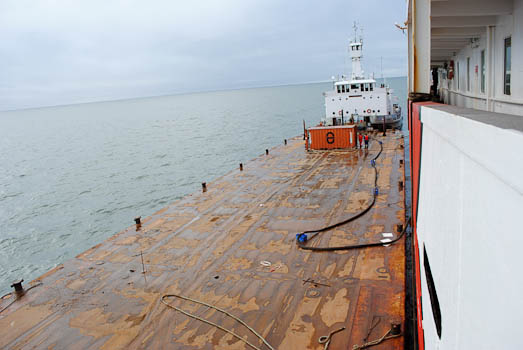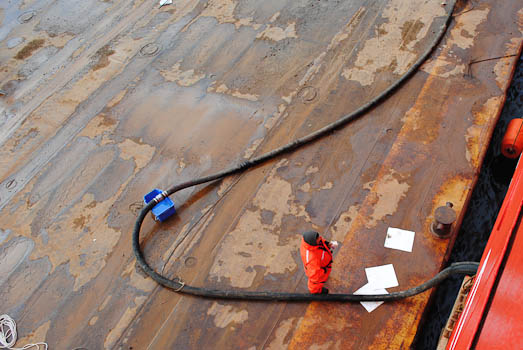Alex KainSeptember 25, 2009Today's refueling evidenced that the Louis is an extremely thirsty ship. She's already sucked up over one-million liters of fuel, and she'll continue slurping until tomorrow afternoon. The refueling process requires constant attention and a fuel barge the size of a football pitch. The scale of the operation is difficult to fathom, so difficult that the following equivalences might be required to bring the staggering quantities into perspective. The ship's fuel tank has a capacity of over 4 million liters (1,056,688 gallons). The ship currently has about 1.1 million liters (290,589 gallons) of fuel on board. By the time the fuel barge is finished, it will have pumped approximately 2 million liters (528,344 gallons) of diesel fuel at a rate of 117,647 liters (31,079 gallons) per hour. Every sixty minutes, the barge pumps enough liquid to fill approximately two residential swimming pools. Every hour, the barge pumps approximately 100 metric tons (110 short tons) of fuel into the ship. By the time fueling is finished, the ship will have approximately 3.1 million liters (818,933 gallons) of fuel on board, a figure equivalent to 2.6 million kilograms (5.8 million pounds) or the mass of about 10,400 fully grown giant pandas.
When traveling through open water, the Louis consumes about 30 cubic meters of diesel per day. This is equivalent to 30,000 liters (7,925 gallons) per day, 1,250 liters (330 gallons) per hour, or 20.8 liters (5.5 gallons) per minute. When all five engines propel the ship through thick ice, the fuel consumption can triple to 90,000 liters (23,775 gallons) per day, or one liter (.26 gallons) every second. Traveling through thick ice for ten minutes uses the same amount of fuel contained in six full Cadillac Escalade tanks. The 2 million liters (528,344 gallons) of fuel pumped to the Louis contains 7.7 million megajoules of energy, roughly the same amount stored in 1.8 million kilograms (4 million pounds) of dynamite.
If the Louis were to pull up to a gas station in Vancouver, BC, that charged the city's average rate, the 2 million liter fueling charge would cost $2.04 million Canadian. If the Louis were to opt for a gas station in Los Angeles that charged the city's mean rate, the same amount would cost $1.38 million American. The energy contained in the mass of fuel is equivalent to 1.8 billion dietary calories, roughly the same amount stored in 7.7 million Kit-Kat bars, or what a person adhering to a 2,500-calorie daily diet would consume in two millennia. Were the volume of fuel pumped into the Louis today to be put into the gas tank of a Toyota Prius, it could travel 40,813,788 kilometers (25,360,512 miles), equivalent to 1,020 trips around the equator or 106 journeys to the moon. This distance is equivalent to four millionths of a light year. But until the Prius can shatter a floe while going 14 knots, I'm sticking with the Louis. All text and photos property of Alex Kain. Last updated: October 7, 2019 | |||||||||||||||
Copyright ©2007 Woods Hole Oceanographic Institution, All Rights Reserved, Privacy Policy. | |||||||||||||||




